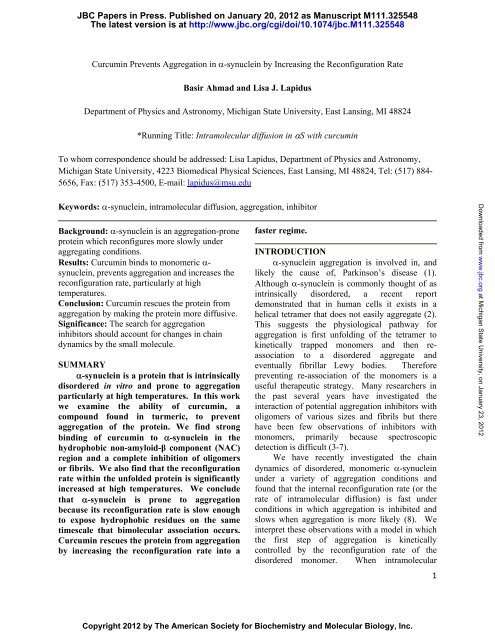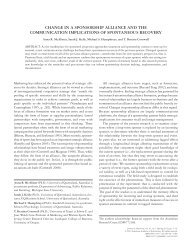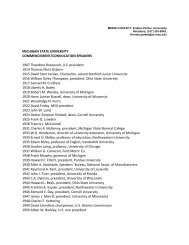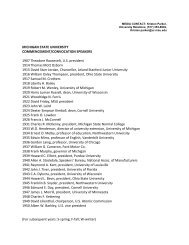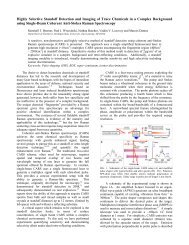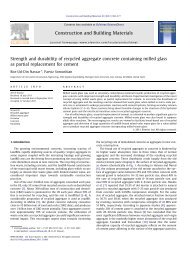Basir Ahmad and Lisa J. Lapidus - Michigan State University
Basir Ahmad and Lisa J. Lapidus - Michigan State University
Basir Ahmad and Lisa J. Lapidus - Michigan State University
Create successful ePaper yourself
Turn your PDF publications into a flip-book with our unique Google optimized e-Paper software.
JBC Papers in Press. Published on January 20, 2012 as Manuscript M111.325548<br />
The latest version is at http://www.jbc.org/cgi/doi/10.1074/jbc.M111.325548<br />
Curcumin Prevents Aggregation in -synuclein by Increasing the Reconfiguration Rate<br />
<strong>Basir</strong> <strong>Ahmad</strong> <strong>and</strong> <strong>Lisa</strong> J. <strong>Lapidus</strong><br />
Department of Physics <strong>and</strong> Astronomy, <strong>Michigan</strong> <strong>State</strong> <strong>University</strong>, East Lansing, MI 48824<br />
*Running Title: Intramolecular diffusion in S with curcumin<br />
To whom correspondence should be addressed: <strong>Lisa</strong> <strong>Lapidus</strong>, Department of Physics <strong>and</strong> Astronomy,<br />
<strong>Michigan</strong> <strong>State</strong> <strong>University</strong>, 4223 Biomedical Physical Sciences, East Lansing, MI 48824, Tel: (517) 884-<br />
5656, Fax: (517) 353-4500, E-mail: lapidus@msu.edu<br />
Keywords: -synuclein, intramolecular diffusion, aggregation, inhibitor<br />
Background: -synuclein is an aggregation-prone<br />
protein which reconfigures more slowly under<br />
aggregating conditions.<br />
Results: Curcumin binds to monomeric synuclein,<br />
prevents aggregation <strong>and</strong> increases the<br />
reconfiguration rate, particularly at high<br />
temperatures.<br />
Conclusion: Curcumin rescues the protein from<br />
aggregation by making the protein more diffusive.<br />
Significance: The search for aggregation<br />
inhibitors should account for changes in chain<br />
dynamics by the small molecule.<br />
SUMMARY<br />
-synuclein is a protein that is intrinsically<br />
disordered in vitro <strong>and</strong> prone to aggregation<br />
particularly at high temperatures. In this work<br />
we examine the ability of curcumin, a<br />
compound found in turmeric, to prevent<br />
aggregation of the protein. We find strong<br />
binding of curcumin to -synuclein in the<br />
hydrophobic non-amyloid-β component (NAC)<br />
region <strong>and</strong> a complete inhibition of oligomers<br />
or fibrils. We also find that the reconfiguration<br />
rate within the unfolded protein is significantly<br />
increased at high temperatures. We conclude<br />
that -synuclein is prone to aggregation<br />
because its reconfiguration rate is slow enough<br />
to expose hydrophobic residues on the same<br />
timescale that bimolecular association occurs.<br />
Curcumin rescues the protein from aggregation<br />
by increasing the reconfiguration rate into a<br />
faster regime.<br />
<br />
INTRODUCTION<br />
-synuclein aggregation is involved in, <strong>and</strong><br />
likely the cause of, Parkinson’s disease (1).<br />
Although -synuclein is commonly thought of as<br />
intrinsically disordered, a recent report<br />
demonstrated that in human cells it exists in a<br />
helical tetramer that does not easily aggregate (2).<br />
This suggests the physiological pathway for<br />
aggregation is first unfolding of the tetramer to<br />
kinetically trapped monomers <strong>and</strong> then reassociation<br />
to a disordered aggregate <strong>and</strong><br />
eventually fibrillar Lewy bodies. Therefore<br />
preventing re-association of the monomers is a<br />
useful therapeutic strategy. Many researchers in<br />
the past several years have investigated the<br />
interaction of potential aggregation inhibitors with<br />
oligomers of various sizes <strong>and</strong> fibrils but there<br />
have been few observations of inhibitors with<br />
monomers, primarily because spectroscopic<br />
detection is difficult (3-7).<br />
We have recently investigated the chain<br />
dynamics of disordered, monomeric -synuclein<br />
under a variety of aggregation conditions <strong>and</strong><br />
found that the internal reconfiguration rate (or the<br />
rate of intramolecular diffusion) is fast under<br />
conditions in which aggregation is inhibited <strong>and</strong><br />
slows when aggregation is more likely (8). We<br />
interpret these observations with a model in which<br />
the first step of aggregation is kinetically<br />
controlled by the reconfiguration rate of the<br />
disordered monomer. When intramolecular<br />
Copyright 2012 by The American Society for Biochemistry <strong>and</strong> Molecular Biology, Inc.<br />
1<br />
Downloaded from<br />
www.jbc.org at <strong>Michigan</strong> <strong>State</strong> <strong>University</strong>, on January 23, 2012
diffusion is fast compared to bimolecular<br />
association, aggregation is unlikely because<br />
exposed hydrophobes quickly reconfigure, but if<br />
intramolecular diffusion slows to the same rate as<br />
bimolecular association, aggregation becomes<br />
more likely. A logical extension of this model is<br />
that aggregation inhibitors prevent bimolecular<br />
association by raising the reconfiguration, or the<br />
rate of intramolecular diffusion, of the disordered<br />
protein.<br />
Intramolecular diffusion is the r<strong>and</strong>om<br />
motion of one part of the protein chain relative to<br />
another. To measure intramolecular diffusion we<br />
use the Trp-Cys contact quenching method by<br />
which Tryptophan is excited to a long-lived triplet<br />
state which is quenched on contact with cysteine<br />
within the same protein chain. Measurement of<br />
this rate of quenching at various temperatures <strong>and</strong><br />
viscosities allows the extraction of the rate of<br />
diffusion between these two points in the chain.<br />
In this work we investigate the effect of the<br />
small molecule curcumin on the intramolecular<br />
diffusion of -synuclein. Curcumin, a compound<br />
found in the spice turmeric, has been shown to<br />
have many medicinal properties <strong>and</strong> inhibits<br />
aggregation of Alzheimer’s peptide An synuclein,<br />
curcumin has been shown to inhibit<br />
fibril formation <strong>and</strong> increase solubility, but the<br />
physical basis of the aggregation inhibition is not<br />
known (10). We find curcumin strongly binds to<br />
the monomer <strong>and</strong> completely inhibits aggregation,<br />
<strong>and</strong> with curcumin intramolecular diffusion of synuclein<br />
is increased more than 10-fold at 40C<br />
compared to the protein alone.<br />
EXPERIMENTAL PROCEDURES<br />
.<br />
-synuclein mutation, expression <strong>and</strong><br />
purification<br />
The -synuclein plasmid was a kind gift from<br />
Gary Pielak at the <strong>University</strong> of North Carolina,<br />
Chapel Hill. 39W/69C <strong>and</strong> 69C/94W mutants of<br />
α-synuclein were created using the QuikChange<br />
site-directed mutagenesis kit (Stratagene, La Jolla,<br />
CA, USA). The mutations were confirmed by<br />
DNA sequencing. The wild-type <strong>and</strong> mutant<br />
proteins were expressed in E. coli BL21 (DE3)<br />
cells transformed with the T7-7 plasmid <strong>and</strong><br />
purified as described previously (11). The mutants<br />
purity was checked by SDS-PAGE to be >95%.<br />
The protein concentration was determined from<br />
the absorbance at 280 nm using extinction<br />
coefficient of 11460 M -1 cm -1 . The stock solutions<br />
of ~200 μΜ were stored at -80 °C in 25 mM<br />
sodium phosphate buffer (pH 7.4) with 1 mM<br />
tris(2-carboxyethyl)phosphine (TCEP). An aliquot<br />
was thawed <strong>and</strong> filtered shortly before each<br />
experiment.<br />
Aggregation inhibition studies<br />
The effect of curcumin on the inhibition of αsynuclein<br />
aggregation was measured in two<br />
aggregation conditions. First, the fibril formation<br />
in the absence <strong>and</strong> presence of curcumin<br />
(curcumin/protein molar ratio =1.5) was initiated<br />
by stirring the protein, at a concentration of 48<br />
µM, in 25 mM phosphate buffer, pH 7.4, 150 mM<br />
NaCl, 1 mM TCEP, 37 C (11). Second, soluble<br />
oligomers formation in the absence <strong>and</strong> presence<br />
of curcumn (curcumin/protein molar ratio =1.5)<br />
was started by incubating the 5 µM α-synuclein in<br />
10% trifluorethanol (TFE) (v/v), 25 mM<br />
phosphate buffer, pH 7.4, 1 mM TCEP, 37 C (12).<br />
At regular times, individual aliquots of 60<br />
(10) µl of each sample pre-incubated without or<br />
with curcumin (curcumin:α-synuclein = 1.5:1)<br />
were mixed with 440 (490) µl 25 µM thioflavine T<br />
(ThT) solution <strong>and</strong> 25 mM phosphate buffer at pH<br />
7.4 <strong>and</strong> the aggregation kinetics was followed by<br />
measurements of ThT fluorescence at 480 nm <strong>and</strong><br />
far-UV circular dichroism (CD) at 217 nm,<br />
respectively. The ThT fluorescence was measured<br />
using a Jobin Yvon Spex Fluorolog-3<br />
spectrofluorimeter equipped with a temperaturecontrolled<br />
cell holder. The excitation <strong>and</strong> emission<br />
wavelengths were 440 <strong>and</strong> 480 nm, respectively.<br />
A 10-mm path-length quartz cell <strong>and</strong> excitation<br />
<strong>and</strong> emission slit width of 5 nm were used. Far UV<br />
CD data were obtained with an Applied<br />
Photophysics Chirascan spectropolarimeter<br />
equipped with a temperature-controlled cell<br />
holder.<br />
Conformational Studies<br />
2<br />
Downloaded from<br />
www.jbc.org at <strong>Michigan</strong> <strong>State</strong> <strong>University</strong>, on January 23, 2012
Intrinsic fluorescence: Tryptophan fluorescence<br />
measurements were carried out on a Jobin Yvon<br />
Spex Fluorolog-3 spectrofluorimeter equipped<br />
with a temperature-controlled cell holder. The<br />
fluorescence spectra were measured at 25 °C with<br />
a 1 cm path length cell, exciting at 295 nm. Both<br />
excitation <strong>and</strong> emission slits were set at 5 nm.<br />
Circular dichroism: CD measurements were<br />
carried out with an Applied Photophysics<br />
Chirascan spectropolarimeter equipped with a<br />
temperature-controlled cell holder. Spectra were<br />
recorded with 0.5-4 s adaptive integration time <strong>and</strong><br />
1 nm b<strong>and</strong>width. Each spectrum was the average<br />
of four scans. Far <strong>and</strong> near-UV CD spectra were<br />
taken at protein concentrations of 5 <strong>and</strong> 25 μM<br />
with 0.1 <strong>and</strong> 1.0 cm path length cells, respectively.<br />
Trp-Cys Contact quenching studies<br />
Shortly before the experiment, a 300 μL<br />
aliquot of the protein with or without the desired<br />
concentration of curcumin was diluted 10:1 in 25<br />
mM sodium phosphate buffer (pH 7.4), 1 mM<br />
TCEP <strong>and</strong> various sucrose concentrations that had<br />
been bubbled with N2O to eliminate oxygen <strong>and</strong><br />
scavenge solvated electrons created in the UV<br />
laser pulse.<br />
Triplet lifetime decay kinetics were measured with<br />
an instrument similar to one described previously<br />
(13). Briefly, the tryptophan triplet is excited by a<br />
10 ns laser pulse at 289 nm created from the 4 th<br />
harmonic of an Nd:YAG laser (Continuum) <strong>and</strong> a<br />
1m Raman cell filled with 450 psi of D2 gas. The<br />
triplet population is probed at 441 nm by a HeCd<br />
laser (Kimmon). The probe <strong>and</strong> a reference beam<br />
are measured by silicon detectors <strong>and</strong> combined in<br />
a differential amplifier (DA 1853A, LeCroy) with<br />
an additional stage of a 350 MHz preamplifier<br />
(SR445A, Stanford Research Systems). The total<br />
gain is 50x. The temperature <strong>and</strong> viscosity were<br />
controlled as described previously (14). The<br />
variation of solution viscosity was achieved with<br />
the addition of different concentrations of sucrose.<br />
Measurement of each sample at 5 temperatures<br />
takes ~20 minutes so aggregation during this time<br />
is minimal. The viscosity of each solvent at each<br />
temperature was measured independently using a<br />
cone-cup viscometer (Brookfield Engineering).<br />
RESULTS<br />
Curcumin binds to monomeric -synuclein<br />
<br />
Binding of curcumin was measured using a variety<br />
of optical absorption <strong>and</strong> fluorescence methods<br />
(see supplementary data for details). As shown in<br />
Fig. 1, curcumin binds strongly to monomeric synuclein<br />
with dissociation constant KD~10 -5 M<br />
without making any significant alteration in the<br />
unfolded state of -synuclein (Fig S1). Measuring<br />
binding at various temperatures we determined the<br />
enthalpy (H=-7.9 kcal/mol) <strong>and</strong> entropy (S=-<br />
0.0081 kcal/mol/K) of binding, indicating the<br />
binding is enthalpically driven <strong>and</strong> suggesting it is<br />
due to non hydrophobic interactions. These<br />
observations are similar to previous reports of<br />
binding of curcumin with proteins such as αs1casein<br />
(15), β-lactoglobulin (16) <strong>and</strong> FtsZ (17).<br />
The binding profiles for the two loops investigated<br />
here are the same, indicating the Trp <strong>and</strong> Cys<br />
mutations are not significantly affecting the<br />
curcumin binding. There is no evidence curcumin<br />
significantly alters the conformational ensemble,<br />
but the tryptophan emission at position 94 shows<br />
significant quenching <strong>and</strong> a slight blue-shift in the<br />
spectrum upon binding of curcumin (see Fig. S2).<br />
No such effect is observed for the tryptophan at<br />
position 39. This suggests an affinity for binding<br />
in the NAC region.<br />
Curcumin strongly inhibits oligomer <strong>and</strong> fibril<br />
formation.<br />
We investigated the effect of curcumin on the<br />
aggregation of 69C/94W mutant of α-synuclein in<br />
two solution conditions. In 25 mM phosphate<br />
buffer of pH 7.4, 150 mM NaCl, 1 mM TCEP, synuclein<br />
at high concentration (48 µM) is known<br />
to form fibrils in 6 days upon stirring at 37C (11),<br />
while in 10 % TFE (v/v) at pH 7.4, -synuclein at<br />
low concentration (5 M) aggregate into soluble<br />
oligomers in 70 minutes at 25 C (12). Figure 2a<br />
<strong>and</strong> 2c show kinetics of 69C/94W mutant<br />
fibrillation <strong>and</strong> oligomerization, respectively in the<br />
absence <strong>and</strong> presence of curcumin monitored with<br />
ThT fluorescence <strong>and</strong> far-UV CD at 217 nm. For<br />
fibrillation, in the absence of curcumin (filled<br />
3<br />
Downloaded from<br />
www.jbc.org at <strong>Michigan</strong> <strong>State</strong> <strong>University</strong>, on January 23, 2012
symbols), sigmoidal kinetics curves were observed<br />
with both the probes indicating a nucleationpolymerization<br />
reaction. Oligomer formation<br />
occurred without a lag phase, shows weak ThT<br />
binding, <strong>and</strong> saturated in 1 hour. However, at the<br />
highest curcumin concentration tested<br />
(curcumin/protein molar ratio 1.5), no increase in<br />
ThT fluorescence or CD values were observed in<br />
either case, indicating that both fibrillation <strong>and</strong><br />
oligomerization are completely prevented.<br />
Fig 2b <strong>and</strong> 2d show the far-UV CD spectra of<br />
the reactants <strong>and</strong> products formed in the absence<br />
<strong>and</strong> presence of curcumin under two aggregation<br />
conditions. In the fibrillation condition<br />
monomeric α-synuclein is characterized by a deep<br />
negative minimum at 198 nm. It has been<br />
previously shown that at very low concentration<br />
(~0.5 µM) α-synuclein exists as monomer between<br />
0-60 % TFE (12), <strong>and</strong> we see a similar partially<br />
folded spectrum with <strong>and</strong> without curcumin in<br />
10% TFE (v/v). In the absence of curcumin,<br />
monomeric reactants incubated in either condition<br />
show a transition from monomeric to a -sheet<br />
structured aggregate with a negative minimum at<br />
217 nm (Fig 2b <strong>and</strong> 2d). In the presence of<br />
curcumin, the spectra of the products in both<br />
aggregation conditions are almost unchanged after<br />
incubation. Taken together, these results suggest<br />
that curcumin at a molar ratio of 1.5:1 completely<br />
prevents the fibrillation <strong>and</strong> oligomer formation of<br />
-synuclein.<br />
Curcumin significantly affects a-synuclein<br />
intramolecular diffusion<br />
We investigated the effect of curcumin on<br />
intramolecular contact rates in two α-synuclein<br />
mutants, 39W/69C <strong>and</strong> 69C/94W by the Trp-Cys<br />
contact quenching method. Tryptophan triplet<br />
kinetics observed for these mutants exhibit a rapid<br />
decay on the microsecond timescale due to<br />
quenching of the tryptophan triplet by contact<br />
with cysteine <strong>and</strong> a second decay on the<br />
millisecond timescale due to other photophysical<br />
processes (18). In the presence of curcumin,<br />
similar triplet decay kinetics was observed for<br />
these mutants. The observed rate of triplet decay<br />
consists of two processes, intramolecular diffusion<br />
<strong>and</strong> irreversible quenching of the triplet by<br />
cysteine on close contact. In equilibrium<br />
intramolecular diffusion brings the Trp <strong>and</strong> Cys<br />
within the same polypeptide together with a<br />
diffusion limited forward rate kD+, where it may be<br />
quenched with rate q or diffuse away with rate kD-.<br />
The observed rate is given by (19)<br />
k<br />
obs<br />
kDq <br />
kD q (1)<br />
If q » kD- then kobs~kD+ <strong>and</strong> the observed rate is<br />
diffusion-limited. However cysteine is not a<br />
diffusion-limited quencher of free tryptophan in<br />
water so q~kD- <strong>and</strong> Eq. 1 can be rewritten as<br />
1 1 1 1 1<br />
<br />
k k qK k ( T , ) k ( T )<br />
obs D D <br />
R<br />
(2)<br />
We assume the reaction-limited rate kR depends<br />
only on temperature (T) but kD+ depends on both<br />
temperature <strong>and</strong> viscosity of the solvent ()<br />
.Therefore, by making measurements at different<br />
viscosities for a constant temperature we can<br />
extract both kR <strong>and</strong> kD+ by fitting a plot of 1/kobs vs.<br />
at a given temperature to a line in which the<br />
intercept is 1/kR <strong>and</strong> the slope is 1/kD+.<br />
This measurement typically assumes that the<br />
cysteine is the only significant quencher in the<br />
sample (20), but it is likely that curcumin is also<br />
an efficient quencher. Fig. 3 shows measured kobs<br />
of -synuclein 69C/94W <strong>and</strong> N-acetyl-Ltryptophanamide<br />
(NATA) in various<br />
concentrations of curcumin. The rates for NATA<br />
increase significantly with curcumin, indicating<br />
curcumin is a very efficient quencher, but the rates<br />
of 94W actually decrease slightly. This suggests<br />
that the curcumin is quite tightly associated with<br />
the protein <strong>and</strong> not free to quench Trp through<br />
bimolecular diffusion. Furthermore, although the<br />
curcumin is probably bound fairly close to 94W<br />
based on the fluorescence measurements (see Fig.<br />
S2), it is apparently not accessible to efficiently<br />
quench the triplet state, suggesting it is buried in a<br />
hydrophobic pocket within the chain. <br />
Figure 4a <strong>and</strong> 4b show plots of exponential<br />
decay times (1/kobs) vs. viscosity for various<br />
temperatures at pH 7.4 in the absence of curcumin<br />
<strong>and</strong> with a curcumin/α-synuclein molar ratio of<br />
1.5:1 respectively. Without curcumin, the intercept<br />
decreases <strong>and</strong> the slope increases dramatically<br />
4<br />
Downloaded from<br />
www.jbc.org at <strong>Michigan</strong> <strong>State</strong> <strong>University</strong>, on January 23, 2012
with temperature. At the highest temperatures,<br />
the intercept is consistent with zero, implying that<br />
kobs is diffusion-limited. In contrast, in the<br />
presence of curcumin, the change in slope is much<br />
more gradual <strong>and</strong> at no temperature is the<br />
observed rate diffusion-limited. This trend is more<br />
similar to trends observed in other unfolded<br />
peptides <strong>and</strong> proteins (13,21).<br />
The reaction-limited (kR) <strong>and</strong> diffusionlimited<br />
(kD+ at the viscosity of water at each<br />
temperature) rates are plotted in Fig 5 for<br />
69C/94W <strong>and</strong> Fig S3 for 39W/69C for various<br />
concentrations of curcumin. The protein<br />
concentration was held fixed at 10 M <strong>and</strong> the<br />
highest concentration of curcumin was 15 M,<br />
beyond which the curcumin absorbed too much<br />
light at 442 nm to make the measurement of the<br />
Trp triplet absorption accurately. In order to<br />
interpret these rates we use a theory by Szabo,<br />
Schulten <strong>and</strong> Schulten (SSS) which models<br />
intramolecular diffusion as diffusion on a 1dimensional<br />
potential of mean force determined by<br />
the probability of intrachain distances (P(r)) (22).<br />
The measured reaction-limited <strong>and</strong> diffusionlimited<br />
rates are given by (23)<br />
<br />
kRq() r P() r dr<br />
d<br />
(3)<br />
lc lc<br />
1 1 dr <br />
2<br />
qx kRP( x) dx<br />
kD kRD <br />
P() r <br />
d r<br />
<br />
(4)<br />
where r is the distance between the tryptophan <strong>and</strong><br />
cysteine, D is the effective intramolecular<br />
diffusion constant <strong>and</strong> q(r) is the distance<br />
dependent quenching rate. The distancedependent<br />
quenching rate for the Trp-Cys system<br />
drops off very rapidly beyond 4.0 Å, so the<br />
reaction-limited rate is mostly determined by the<br />
probability of the shortest distances (24). Very<br />
generally, kR <strong>and</strong> kD+ are both inversely<br />
proportional to the average volume of the chain<br />
<strong>and</strong> kD+ is directly proportional to D. Therefore in<br />
the absence of curcumin the large increase in kR<br />
represents a significant compaction in the size of<br />
the protein <strong>and</strong> the moderate decrease in kD+<br />
represents a significant slowing in diffusion as<br />
2<br />
temperature is increased. The reconfiguration rate<br />
can be defined as the rate to diffuse one part of the<br />
chain across the diameter of the protein<br />
kr=4D/(2RG) 2 .<br />
To determine the diffusion constant we assume the<br />
probability distribution is given by a Gaussian<br />
chain<br />
3/2<br />
2 2<br />
4r 3 3r<br />
<br />
Pr () exp<br />
<br />
2 2<br />
N 2r 2 r <br />
(5)<br />
where , the average Trp-Cys distance, is an<br />
adjustable parameter, <strong>and</strong> N is a normalization<br />
constant such that Pr () 1.<br />
For each measured<br />
kR, was found such that it matched the<br />
measured rate using Eq. 3. These distances are<br />
plotted in Fig 5c. Then the correct P(r) was used<br />
in Eq. 4 with the measured kD+ to determine D,<br />
plotted in Fig. 5d. Without any curcumin, D<br />
decreases by ~50-fold from 0 to 40 C. The<br />
addition of curcumin has a small effect on the size<br />
of the chain <strong>and</strong> the diffusion constant at low<br />
temperature but the effect increases dramatically at<br />
high temperature. Since the binding curves<br />
suggested that curcumin was preferentially<br />
binding near 94W we repeated these<br />
measurements with mutant 39W/69C (see Fig. S3)<br />
<strong>and</strong> found qualitatively similar results, suggesting<br />
curcumin affects the global dynamics of the<br />
protein.<br />
DISCUSSION<br />
We have previously shown that -synuclein,<br />
uniquely among disordered sequences, compacts<br />
<strong>and</strong> diffuses more slowly as temperature is<br />
increased (14). Examining other conditions in<br />
which aggregation is enhanced (low pH or the<br />
familial mutation A30P) we find good correlation<br />
between the rate of intramolecular diffusion <strong>and</strong><br />
the rate of aggregation. When diffusion is fast<br />
(D~10<br />
5<br />
-6 cm 2 s -1 ), such as is observed for most<br />
intrinsically disordered sequences, the protein<br />
reconfigures too fast to make stable bimolecular<br />
interactions with another protein chain, but when<br />
reconfiguration rate is about the same as the<br />
Downloaded from<br />
www.jbc.org at <strong>Michigan</strong> <strong>State</strong> <strong>University</strong>, on January 23, 2012
imolecular encounter rate, stable interactions are<br />
more likely <strong>and</strong> aggregation can proceed. This<br />
accounts for the dramatic increase in aggregation<br />
rate of -synuclein at 40 C compared to 0 C.<br />
In this work we have examined the effect of<br />
curcumin binding on intramolecular diffusion of<br />
-synuclein. There is little difference in D at T=0<br />
C but the difference widens with increasing<br />
temperature. At T=40 C <strong>and</strong> equal molar ratio of<br />
curcumin to protein, D is 15 times higher than<br />
with no curcumin. This difference widens to 30<br />
times at 1.5:1 curcumin:protein, the highest ratio<br />
measurable in our instrument which suggests that<br />
multiple curcumin bound to a single protein<br />
further increases D.<br />
The Trp fluorescence data suggests one<br />
preferred binding site for curcumin is near position<br />
94. Molecular mechanics simulations of<br />
Alzheimer’s peptides have shown that curcumin<br />
preferentially associates with alanine <strong>and</strong> other<br />
aliphatic residues (25). Between residues 60 <strong>and</strong><br />
100 there are 15 aliphatic residues (alanine <strong>and</strong><br />
valine, plus L100), <strong>and</strong> in particular there are three<br />
alanines in a row at positions 89-91. We propose<br />
this as a possible binding site. Having made one<br />
or more bonds between the side chains <strong>and</strong> the<br />
curcumin, the aromatic rings of the molecule are<br />
then available to interact with any of the nearby<br />
hydrophobic residues, creating a hydrophobic<br />
cluster of residues close in sequence.<br />
Thus it appears that one or more curcumin<br />
bound to -synuclein rescues the protein from the<br />
slow diffusion regime that promotes aggregation.<br />
Since the reaction-limited rates are correlated with<br />
temperature <strong>and</strong> the diffusion-limited rates are<br />
inversely correlated, by extension the chain<br />
volume <strong>and</strong> diffusion coefficient are inversely<br />
correlated. We conclude curcumin disrupts longrange<br />
interactions within the chain, allowing it to<br />
more quickly reconfigure. Fig. 6 shows a<br />
schematic of this behavior. Typically -synuclein<br />
is a fairly compact disordered protein with many<br />
long-range interactions within the chain (gray<br />
circles). This makes reconfiguration fairly slow<br />
(top row) <strong>and</strong> allows exposed hydrophobes to<br />
associate with other chains making oligomers,<br />
which eventually rearrange into larger fibrillar<br />
species. With the addition of curcumin (middle<br />
row), the chains become less compact <strong>and</strong><br />
intramolecular interactions are more short range<br />
allowing faster reconfiguration. Faster<br />
reconfiguration allows the chains to escape from<br />
bimolecular association (bottom row) <strong>and</strong> prevents<br />
further aggregation steps.<br />
Future work should investigate whether this<br />
property is common in aggregation inhibitors. For<br />
example, as a control experiment we have<br />
measured intramolecular diffusion of the protein in<br />
the presence of N-acetyl-Leucine, a hydrophobic<br />
amino acid <strong>and</strong> find the diffusion coefficient is<br />
unchanged (see figure S4), suggesting that<br />
curcumin’s ability to affect reconfiguration is<br />
somewhat unique.<br />
This assay yields unique information about<br />
the mechanism of aggregation inhibition at the<br />
first step of process. More common assays, such<br />
as ThT fluorescence, are not sensitive to<br />
monomer/monomer interactions which are the<br />
preferred step for an inhibitor to act on. One<br />
potential danger with inhibiting a later step of<br />
aggregation pathway is that accumulation of a<br />
toxic intermediate could make toxicity worse (26).<br />
Therefore this measurement should become a<br />
common assay in the development of new<br />
Parkinson’s drug c<strong>and</strong>idates that prevent<br />
aggregation at the first step.<br />
Acknowledgements We thank Charles<br />
Hoogstraten for helpful discussions, Gary Pielak<br />
for the kind gift of the -synuclein plasmid, <strong>and</strong><br />
Terry Ball for mutation <strong>and</strong> expression of the<br />
protein. This work is supported by the National<br />
Science Foundation (NSF MCB-0825001). We<br />
wish to acknowledge the support of the <strong>Michigan</strong><br />
<strong>State</strong> <strong>University</strong> High Performance Computing<br />
Center <strong>and</strong> the Institute for Cyber Enabled<br />
Research.<br />
6<br />
Downloaded from<br />
www.jbc.org at <strong>Michigan</strong> <strong>State</strong> <strong>University</strong>, on January 23, 2012
The abbreviations used are: S, -synuclein; Cur, Curcumin; NAC, non-amyloid-β component; TCEP,<br />
tris(2-carboxyethyl)phosphine; ThT, thioflavine T; TFE, trifluorethanol; NATA, N-acetyl-Ltryptophanamide<br />
References<br />
1. Goedert, M. (2001) Nat Rev Neurosci 2, 492-501<br />
2. Bartels, T., Choi, J. G., <strong>and</strong> Selkoe, D. J. (2011) Nature 477, 107-U123<br />
3. Amer, D. A. M., Irvine, G. B., <strong>and</strong> El-Agnaf, O. M. A. (2006) Experimental Brain Research 173,<br />
223-233<br />
4. Caruana, M., Högen, T., Levin, J., Hillmer, A., Giese, A., <strong>and</strong> Vassallo, N. (2011) FEBS Letters<br />
585, 1113-1120<br />
5. Ehrnhoefer, D. E., Bieschke, J., Boeddrich, A., Herbst, M., Masino, L., Lurz, R., Engemann, S.,<br />
Pastore, A., <strong>and</strong> Wanker, E. E. (2008) Nature Structural & Molecular Biology 15, 558-566<br />
6. Lamberto, G. R., Binolfi, A., Orcellet, M. L., Bertoncini, C. W., Zweckstetter, M., Griesinger, C.,<br />
<strong>and</strong> Fernández, C. O. (2009) Proceedings of the National Academy of Sciences 106, 21057-21062<br />
7. Zhu, M., Rajamani, S., Kaylor, J., Han, S., Zhou, F., <strong>and</strong> Fink, A. L. (2004) J Biol Chem 279,<br />
26846-26857<br />
8. <strong>Ahmad</strong>, B., Chen, Y., <strong>and</strong> <strong>Lapidus</strong>, L. J. (January 16, 2012) PNAS, 10.1073/pnas.1109526109<br />
9. Yang, F. S., Lim, G. P., Begum, A. N., Ubeda, O. J., Simmons, M. R., Ambegaokar, S. S., Chen,<br />
P. P., Kayed, R., Glabe, C. G., Frautschy, S. A., <strong>and</strong> Cole, G. M. (2005) J Biol Chem 280, 5892-<br />
5901<br />
10. P<strong>and</strong>ey, N., Strider, J., Nolan, W. C., Yan, S. X., <strong>and</strong> Galvin, J. E. (2008) Acta Neuropathologica<br />
115, 479-489<br />
11. Uversky, V. N., Li, J., <strong>and</strong> Fink, A. L. (2001) J Biol Chem 276, 10737-10744<br />
12. Anderson, V. L., Ramlall, T. F., Rospigliosi, C. C., Webb, W. W., <strong>and</strong> Eliezer, D. (2010)<br />
Proceedings of the National Academy of Sciences of the United <strong>State</strong>s of America 107, 18850-<br />
18855<br />
13. Singh, V. R., Kopka, M., Chen, Y., Wedemeyer, W. J., <strong>and</strong> <strong>Lapidus</strong>, L. J. (2007) Biochemistry<br />
46, 10046-10054<br />
14. <strong>Ahmad</strong>, B., Chen, Y., <strong>and</strong> <strong>Lapidus</strong>, L. J. (2011) PNAS (in press)<br />
15. Sneharani, A. H., Singh, S. A., <strong>and</strong> Rao, A. G. A. (2009) Journal of Agricultural <strong>and</strong> Food<br />
Chemistry 57, 10386-10391<br />
16. Sneharani, A. H., Karakkat, J. V., Singh, S. A., <strong>and</strong> Rao, A. G. A. (2010) Journal of Agricultural<br />
<strong>and</strong> Food Chemistry 58, 11130-11139<br />
17. Rai, D., Singh, J. K., Roy, N., <strong>and</strong> P<strong>and</strong>a, D. (2008) Biochem J 410, 147-155<br />
18. <strong>Lapidus</strong>, L. J., Eaton, W. A., <strong>and</strong> Hofrichter, J. (2000) Proceedings of the National Academy of<br />
Sciences of the United <strong>State</strong>s of America 97, 7220-7225<br />
19. <strong>Lapidus</strong>, L. J., Eaton, W. A., <strong>and</strong> Hofrichter, J. (2002) Journal of Molecular Biology 319, 19-25<br />
20. Gonnelli, M., <strong>and</strong> Strambini, G. B. (1995) Biochemistry 34, 13847-13857<br />
21. Chen, Y. J., Parrini, C., Taddei, N., <strong>and</strong> <strong>Lapidus</strong>, L. J. (2009) Journal of Physical Chemistry B<br />
113, 16209-16213<br />
22. Szabo, A., Schulten, K., <strong>and</strong> Schulten, Z. (1980) Journal of Chemical Physics 72, 4350-4357<br />
23. <strong>Lapidus</strong>, L. J., Steinbach, P. J., Eaton, W. A., Szabo, A., <strong>and</strong> Hofrichter, J. (2002) Journal of<br />
Physical Chemistry B 106, 11628-11640<br />
24. <strong>Lapidus</strong>, L. J., Eaton, W. A., <strong>and</strong> Hofrichter, J. (2001) Physical Review Letters 87, 4<br />
25. Kumar, P., Pillay, V., Choonara, Y. E., Modi, G., Naidoo, D., <strong>and</strong> du Toit, L. C. (2011)<br />
International Journal of Molecular Sciences 12, 694-724<br />
26. Ross, C. A., <strong>and</strong> Poirier, M. A. (2004) Nature Medicine 10, S10-S17<br />
7<br />
Downloaded from<br />
www.jbc.org<br />
at <strong>Michigan</strong> <strong>State</strong> <strong>University</strong>, on January 23, 2012
Figure Legends<br />
Figure 1. Curcumin--synuclein binding as measured by (a) curcumin difference absorption at 404 nm,<br />
(b) curcumin fluorescence at 512 nm after exciting the protein at 430 nm <strong>and</strong> (c) <strong>and</strong> (d) tryptophan<br />
fluorescence at 355nm after exciting the samples at 295 nm. In panel a <strong>and</strong> b curcumin concentration is<br />
10 M <strong>and</strong> in panels c <strong>and</strong> d -synuclein concentration is 10 M Lines are fits to Eq. S2 for (a) <strong>and</strong> (c)<br />
n=1 (black lines) <strong>and</strong> n=2 (grey lines) <strong>and</strong> for (b) as marked. All lines in (d) are for n=1.<br />
Figure 2. Effect of curcumin on fibrillation ((a) <strong>and</strong> (b)) <strong>and</strong> soluble oligomer formation ((c) <strong>and</strong> (d)) of αsynuclein<br />
measured using ThT fluorescence <strong>and</strong> ellipticity at 217 nm as marked. (a) Kinetics of<br />
fibrillation in 25 mM phosphate buffer of pH 7.4, 150 mM NaCl, 1 mM TCEP, at the protein<br />
concentrations of 48 µM, upon stirring at 37 C (b) Far-UV CD spectra of native α-synuclein <strong>and</strong> products<br />
of fibrillation obtained in condition “a” in the absence <strong>and</strong> presence of curcumin (curcumin/α-synuclein<br />
molar ratio = 1.5) (c) Kinetics of oligomerization at the protein concentrations of 5 µM, in 10 % TFE<br />
(v/v), 25 mM phosphate buffer of pH 7.4, 1 mM TCEP at 25C measured using ThT fluorescence <strong>and</strong><br />
ellipticity at 217 nm. (d) Far-UV CD spectra of reactants obtained at the protein concentration of 0.4M<br />
in 10% TFE (v/v) <strong>and</strong> products formed at the protein concentrations of 5 µM in 10% TFE (v/v) of<br />
oligomerization process in the absence <strong>and</strong> presence of curcumin (curcumin/α-synuclein molar ratio =<br />
1.5). Since at very low concentration (
FIGURE 1<br />
absorbance (mOD)<br />
Trp fluorescence<br />
0.2<br />
0.1<br />
0.0<br />
0 10 20 30 40<br />
3e+6<br />
2e+6<br />
[-synuclein] (M)<br />
curcumin fluorescence<br />
Relative Trp fluorescence<br />
6e+5<br />
a b<br />
1e+6<br />
0 10 20 30 40<br />
[curcumin] (M)<br />
4e+5<br />
2e+5<br />
0<br />
1.0 5 C<br />
15 C<br />
0.8<br />
20 C<br />
25 C<br />
0.6<br />
94W<br />
n=1 fit 94W<br />
n=2 fit 94W<br />
39W<br />
n=1 fit 39W<br />
n=2 fit 39W<br />
0 10 20 30 40<br />
[-synuclein] (M)<br />
c d<br />
0.4<br />
0 10 20 30<br />
[curcumin] (M)<br />
9<br />
Downloaded from<br />
www.jbc.org<br />
at <strong>Michigan</strong> <strong>State</strong> <strong>University</strong>, on January 23, 2012
FIGURE 2<br />
ThT fluorescence (a.u.)<br />
ThT fluorescence (a.u.)<br />
160<br />
120<br />
80<br />
40<br />
0<br />
10<br />
8<br />
6<br />
4<br />
2<br />
pH 7.4, 48 M S<br />
ThT, Cur/S = 0<br />
ThT, Cur/ S = 1.5<br />
CD, Cur/S = 0<br />
CD, Cur/S = 1.5<br />
0 20 40 60 80 100 120 140 160<br />
Time (hours)<br />
c<br />
-10<br />
-9<br />
15<br />
10<br />
d<br />
10% TFE (v/v)<br />
Cur/S = 0, 0.4 M S (5min)<br />
Cur/S = 1.5, 0.4 M S(5 min)<br />
10% TFE (v/v), 5 M S -8<br />
5<br />
Cur/S = 0, 5 M s(70 min )<br />
Cur/S = 1.5, 5 M s(70 min)<br />
ThT, Cur/S = 0<br />
0<br />
ThT, Cur/S = 1.5<br />
CD, Cur/S = 0<br />
CD, Cur/S = 1.5<br />
-7<br />
-5<br />
-6<br />
-10<br />
0<br />
-5<br />
0 20 40<br />
Time (min)<br />
60 80<br />
-5 5<br />
a b<br />
-4<br />
-3<br />
-2<br />
[] ( 10 3 deg cm 2 dmol -1 )<br />
[] (10 3 deg cm 2 dmol -1 )<br />
0<br />
-5<br />
-10<br />
pH 7.4, 48 M S<br />
Cur/S = 0 (5 min)<br />
Cur/S = 1.5 (5 min)<br />
Cur/S = 0, 143 hrs<br />
Cur/S=1.5, 143 hrs<br />
-15<br />
190 200 210 220 230 240 250<br />
Wavelength [nm]<br />
-15<br />
190 200 210 220 230 240 250<br />
Wavelength [nm]<br />
10<br />
Downloaded from<br />
www.jbc.org<br />
at <strong>Michigan</strong> <strong>State</strong> <strong>University</strong>, on January 23, 2012
FIGURE 3<br />
k obs (1/s)<br />
5e+5<br />
4e+5<br />
3e+5<br />
2e+5<br />
1e+5<br />
0<br />
NATA<br />
-Synuclein<br />
0 2 4 6 8 10<br />
[curcumin] (M)<br />
11<br />
Downloaded from<br />
www.jbc.org<br />
at <strong>Michigan</strong> <strong>State</strong> <strong>University</strong>, on January 23, 2012
FIGURE 4<br />
1/kobs (s)<br />
1/kobs (s)<br />
12<br />
10<br />
8<br />
6<br />
4<br />
2<br />
0<br />
0 2 4<br />
(cp)<br />
6 8<br />
12<br />
10<br />
8<br />
6<br />
4<br />
2<br />
b<br />
a<br />
0<br />
0 2 4 6 8<br />
(cp)<br />
0C<br />
10C<br />
15C<br />
20C<br />
30C<br />
40C<br />
12<br />
Downloaded from<br />
www.jbc.org at <strong>Michigan</strong> <strong>State</strong> <strong>University</strong>, on January 23, 2012
FIGURE 5<br />
k R (s -1 )<br />
1/2 (Angstrom)<br />
10 7<br />
10 6<br />
10 5<br />
100<br />
80<br />
60<br />
40<br />
20<br />
0<br />
0:1<br />
0.5:1<br />
1:1<br />
1.5:1<br />
k D+ (s -1 )<br />
0 10 20 30 40 0 10 20 30 40<br />
10<br />
c d<br />
0 10 20 30 40<br />
T (C)<br />
a<br />
D x10 6 (cm 2 s -1 )<br />
10 7<br />
10 6<br />
10 5<br />
1<br />
0.1<br />
0.01<br />
0 10 20 30 40<br />
T (C)<br />
b<br />
13<br />
Downloaded from<br />
www.jbc.org at <strong>Michigan</strong> <strong>State</strong> <strong>University</strong>, on January 23, 2012
FIGURE 6<br />
kr~D<br />
Without curcumin, slow diffusion<br />
+<br />
+<br />
With curcumin, fast diffusion<br />
kbi<br />
kbi<br />
+<br />
kr~D<br />
14<br />
Downloaded from<br />
www.jbc.org at <strong>Michigan</strong> <strong>State</strong> <strong>University</strong>, on January 23, 2012


